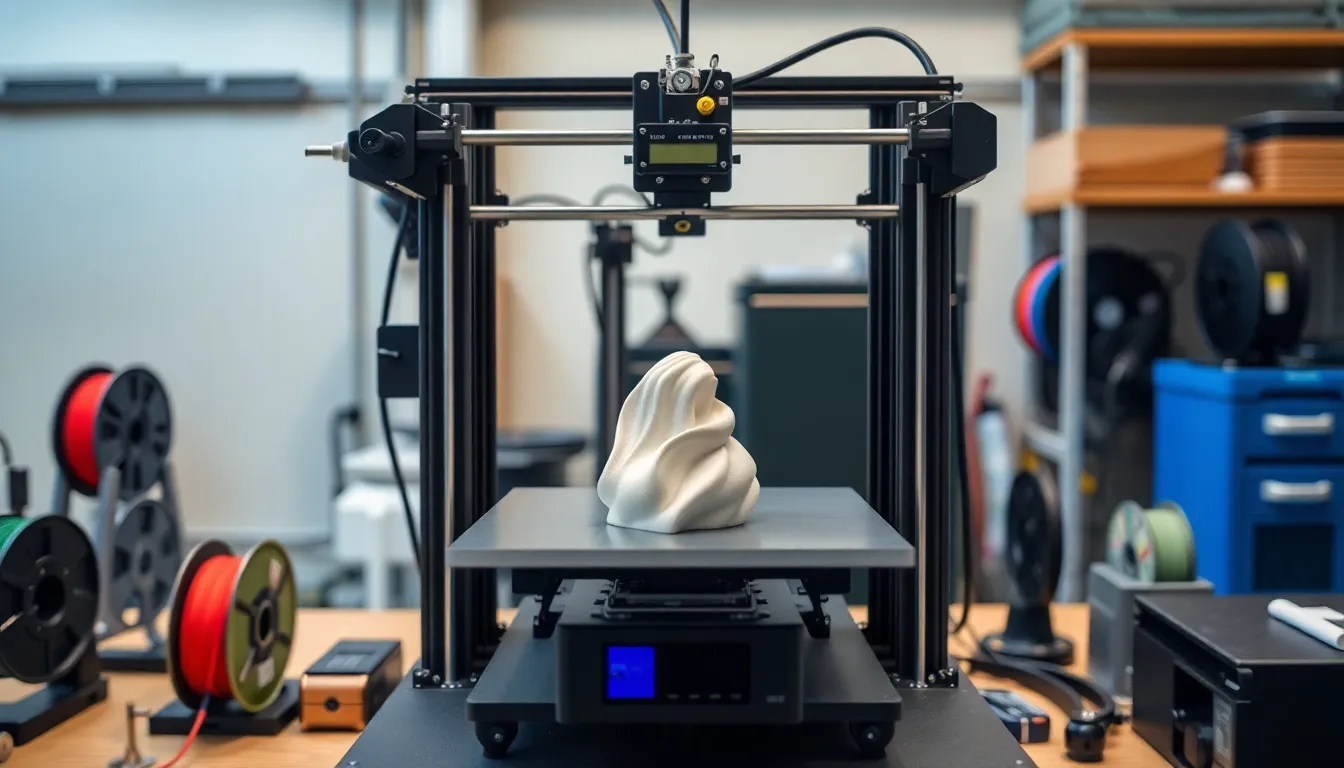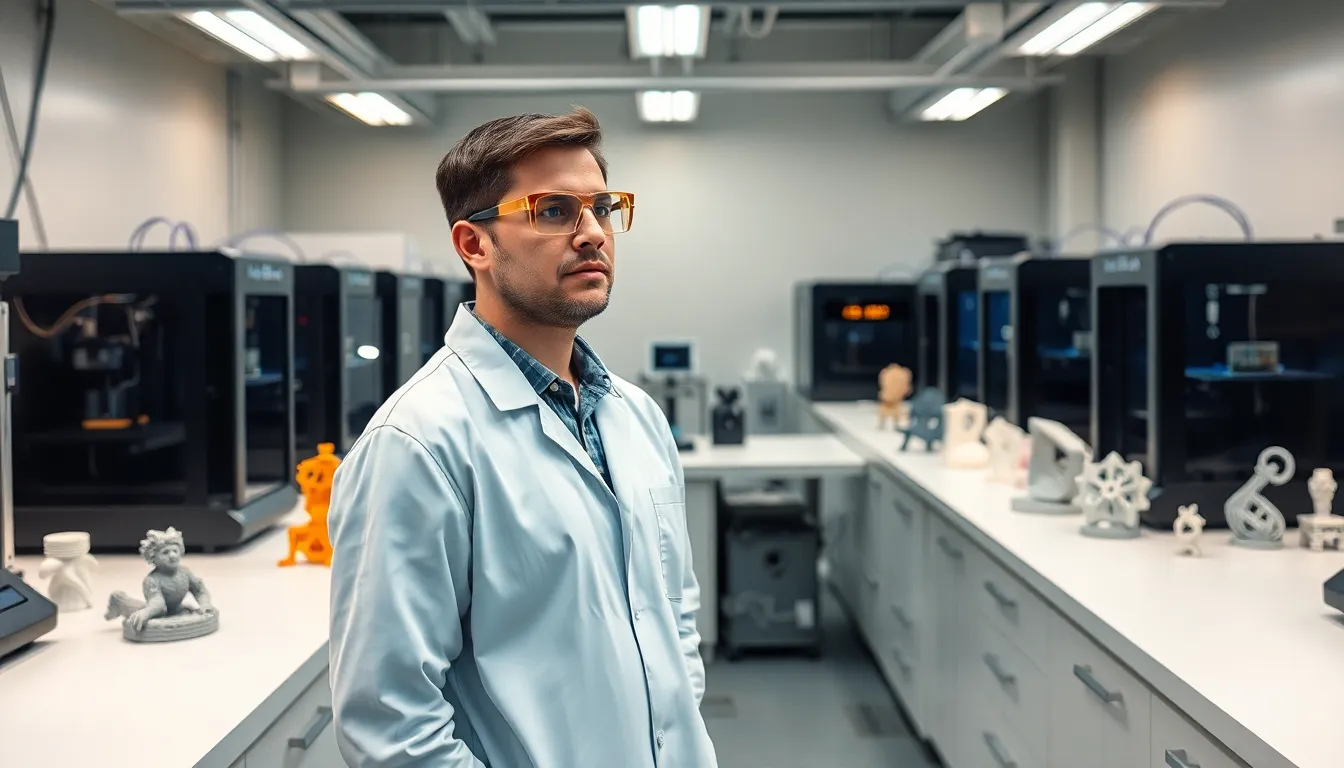In the rapidly evolving world of manufacturing, 3D printers are revolutionizing the way products are designed and produced. As industries seek to streamline processes and cut costs, understanding 3D printer efficiency has become crucial. This efficiency not only impacts production speed but also influences material usage and overall sustainability.
By optimizing 3D printing techniques, businesses can significantly enhance their output while minimizing waste. Whether it’s through advanced technology or innovative strategies, achieving higher efficiency levels can lead to remarkable improvements in both quality and profitability. As the demand for rapid prototyping and custom solutions grows, exploring the nuances of 3D printer efficiency is more important than ever for anyone looking to stay competitive in the market.
Table of Contents
ToggleUnderstanding 3D Printer Efficiency
3D printer efficiency refers to how effectively a 3D printer uses resources during the printing process. It includes factors such as speed, material consumption, and energy usage, all of which impact production capabilities and sustainability.
Definition of 3D Printer Efficiency
3D printer efficiency encompasses several key performance indicators. Speed measures the time taken to print an object, often expressed in millimeters per second (mm/s). Material usage focuses on the amount of filament required for a print job, determining waste levels and cost. Energy consumption assesses how much power the printer uses during operation, providing insight into operational costs and environmental impact.
Importance in 3D Printing
3D printer efficiency plays a crucial role in various aspects of production. First, it directly influences production speed, enabling faster turnaround times for projects. Second, efficient material usage minimizes waste, which lowers costs and promotes sustainable practices. Third, energy-efficient printers reduce operational expenses and environmental footprints, contributing to greener manufacturing processes. Lastly, understanding efficiency is vital for staying competitive in a market that increasingly demands rapid prototyping and custom solutions. Businesses that optimize efficiency enhance their overall output, quality, and profitability.
Factors Affecting 3D Printer Efficiency

Several factors contribute to the efficiency of 3D printers, including print speed, material usage, and energy consumption. Understanding these elements aids manufacturers in optimizing their production processes.
Print Speed
Print speed measures the rate at which a 3D printer produces objects, directly impacting overall efficiency. Faster print speeds reduce production time, allowing for quicker turnaround on projects. However, higher speeds may compromise quality, resulting in layer adhesion issues or surface finish imperfections. Balancing speed and quality is crucial, as choosing optimal settings enhances printer performance without sacrificing product integrity.
Material Usage
Material usage quantifies the amount of filament utilized during the printing process. Efficient material management minimizes waste, cuts costs, and promotes sustainability. Factors influencing material usage include the design of the object being printed, printer settings, and the type of filament selected. Utilizing slicing software effectively can optimize pathways, reducing excess material and improving overall efficiency. Proper calibration of the printer ensures minimal filament is converted to scrap.
Energy Consumption
Energy consumption refers to the power required to operate a 3D printer, affecting operational costs and environmental impact. More energy-efficient models use advanced technologies and better algorithms to reduce power usage without sacrificing performance. Factors influencing energy consumption include print speed, heating time, and motor efficiency. Selecting energy-efficient printers and optimizing settings can lead to significant savings in energy costs while promoting environmentally friendly practices.
Measuring 3D Printer Efficiency
Measuring 3D printer efficiency involves analyzing various metrics that indicate performance. Understanding these metrics aids in fine-tuning processes for optimal output.
Common Metrics
- Print Speed: Measures the time taken to complete a print job, typically expressed in millimeters per second (mm/s). Higher speeds can increase productivity but may impact detail.
- Material Consumption: Quantifies the amount of filament or resin used during printing. Minimizing material waste directly enhances cost-effectiveness.
- Energy Consumption: Assesses the power usage throughout the printing process, often measured in kilowatt-hours (kWh). Energy-efficient printers lower operational costs and reduce environmental footprints.
- Layer Adhesion: Evaluates the bonding strength between printed layers, affecting the durability and quality of the final product. Strong adhesion improves the overall performance of the printed object.
- Print Success Rate: Indicates the ratio of successful prints to total attempts. Higher rates reflect reliability in the printing process and reduce wasted resources.
Evaluating Different Models
- Speed and Quality Balance: When choosing a 3D printer model, consider its ability to balance speed and quality. Models that offer adjustable speed settings provide flexibility in satisfying different project requirements.
- Energy Efficiency Ratings: Look for models with energy efficiency certifications, such as ENERGY STAR. These ratings provide insights into the printer’s power consumption compared to traditional models.
- Material Compatibility: Assess the types of materials a printer can handle. Models supporting a broad range of filaments or resins allow for versatile applications and improved material utilization.
- Calibration Tools: Evaluate models featuring built-in calibration tools. Effective calibration reduces material waste and enhances print quality, contributing to overall efficiency.
- Cost of Ownership: Analyze the total cost of ownership, including initial purchase price, maintenance, and consumable costs. Lower overall expenses across a printer’s lifespan reflect better efficiency.
By focusing on these metrics and evaluation criteria, businesses can effectively measure and enhance their 3D printer efficiency, driving improved production processes.
Improving 3D Printer Efficiency
Optimizing 3D printer efficiency involves refining print settings and selecting appropriate materials. These factors significantly impact production speed, quality, and overall resource utilization.
Optimizing Print Settings
Optimized print settings enhance efficiency by increasing speed and ensuring quality. Adjusting layer height, print speed, and temperature directly influences print results.
- Layer height: A smaller layer height improves detail but increases print time; balancing detail with efficiency is critical.
- Print speed: Higher speeds reduce production time but might compromise adhesion. Finding an optimal speed enhances both quality and efficiency.
- Extrusion temperature: Correct temperature settings ensure proper filament flow, reducing jams and material waste. Manufacturers often provide recommended temperatures for various materials.
Utilizing slicer software effectively allows users to customize print settings based on specific project requirements, maximizing efficiency for different applications.
Choosing the Right Materials
Selecting compatible materials is essential for maintaining efficiency and quality. Each material has unique properties that can affect print performance.
- Filament type: Different filaments, such as PLA, ABS, or PETG, offer various benefits. Choosing based on application needs optimizes results.
- Material cost: Cost-effective materials decrease overall expenses. Higher-quality materials may require higher initial investment but yield better long-term outcomes.
- Printability: Some materials are easier to print with minimal settings adjustment. Assessing a material’s printability helps streamline the production process.
By integrating suitable materials and optimized print settings, businesses enhance 3D printer efficiency and achieve superior outputs.
Maximizing 3D printer efficiency is crucial for businesses aiming to enhance production processes and maintain a competitive edge. By focusing on key performance indicators like speed, material usage, and energy consumption, companies can streamline operations and reduce costs.
Implementing optimized print settings and selecting the right materials further boosts efficiency and output quality. As the landscape of manufacturing evolves, embracing these strategies will not only improve profitability but also promote sustainable practices.
Investing in energy-efficient models and understanding the total cost of ownership will pave the way for a more productive and environmentally conscious future in 3D printing.




